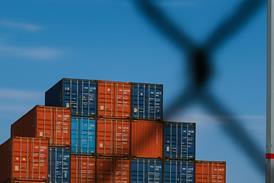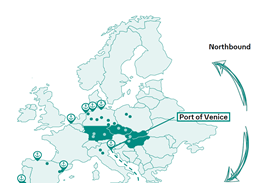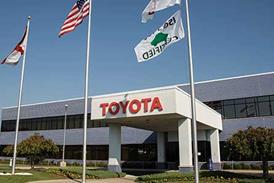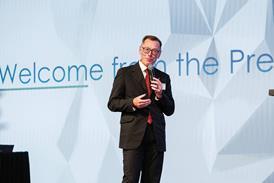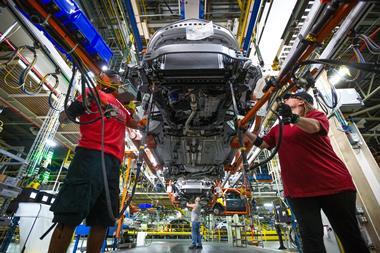 GM’s executive director of global logistics, Edgard Pezzo, left, talks to Christopher Ludwig about cutting waste and cost in a multi-billion dollar supply chain.
GM’s executive director of global logistics, Edgard Pezzo, left, talks to Christopher Ludwig about cutting waste and cost in a multi-billion dollar supply chain.
When Edgard Pezzo took over as executive director of global logistics and containerisation at General Motors, in May 2013, the top logistics purchasing management job came with a mandate to reduce logistics and supply chain costs. Grace Lieblein, who was appointed the carmaker’s purchasing chief as vice-president of global purchasing and supply chain (GPSC) just a few months prior to Pezzo’s appointment, had said that General Motors would trim its multi-billion dollar global logistics budget over the coming years even amid a raft of new model launches by, among other things, bringing suppliers closer to assembly and investing in logistics infrastructure at plants.
A year can be a short time in the supply chain, especially one as sprawling and complex as General Motors’; it is hard to make major changes in such a span. Suppliers have historic footprints and capabilities in certain regions – or indeed, lack them in places – and adding locations is not as simple as moving house. Vehicle models and programmes take years of planning, with logistics and supply operations rarely the most influential factors. Many a logistics department at carmakers much smaller and with fewer decision-making and management layers than GM have had to determine their transport and inventory strategies after most supplier and plant decisions were already fixed.
Few understand this reality as well as Pezzo, who has worked more than 20 of his nearly 30-year career at GM in supplier quality, purchasing and supply chain, including most recently as vice-president of GPSC for South America. To some extent, the objectives ahead of him are familiar. He previously worked with Lieblein in Brazil when she was GM’s president in the country, credited with improving production and sourcing decisions by better integrating purchasing and logistics with global product development. It is an approach that Pezzo has adapted in his global role by trying to position logistics upfront in the model planning and development phase, thus better capturing logistics cost and benefits from model launch through serial production and distribution.
“As logistics, we are positioning ourselves in such a way as to make sure that we work with purchasing, manufacturing, finance and all other stakeholders internally, as well as with suppliers externally, so that when we have a new project, we deliver the information and also participate in the modelling of all possible scenarios,” says Pezzo.
This ambition may not sound different to the approaches for ‘total enterprise cost’ and better collaboration between GM departments to which Pezzo’s predecessors have also aspired. Certainly, efforts to integrate GM’s sourcing and planning management have been ongoing for the past decade. For a purchasing department responsible for $80 billion or more per year, it was never going to be easy or quick.
What’s different this time around seems to be, in part, the focus on supply chain and logistics implications across the organisation. A rise in logistics costs in North America and globally appears to have rallied senior management to the cause. Anyone who has worked at or with GM over the past year is well aware of the company’s cost objectives.

However, while the headline may be about reducing cost, the real focus, says Pezzo, is to eliminate waste. He acknowledges that the word itself can be fraught: one company’s wasteful transport spending might be strategic (or profitable) to another. Nevertheless, he sees opportunities where GM, a tier supplier and a logistics provider could all benefit from changes, such as through better material order processes to eliminate extra inventory, and in more efficient routing.
Perhaps one of the surest signs that GM’s target is not a simple ‘cost-down’ push on suppliers is the recognition that money may need to be spent on logistics to improve it. There are regions where GM is now increasing its tooling or shifting its in-house component production closer to plants. Examples include stamping plants in the US, including a new investment this past summer in Lansing, Michigan at its assembly plant. Last year, the company also announced a number of multi-million dollar projects in North America to connect plants to nearby rail networks and build logistics centres. Earlier this year, the company’s European division told Automotive Logistics of the benefits a new material ordering and forecast system had brought.
Currently, Pezzo points to efforts to research and develop better pack density for parts and containers in the supply chain, as well as a global system to track and trace packaging assets. He is also interested in expanding the services that GM receives in some emerging markets where logistics capabilities have grown. For example, aspects of the ‘lead logistics provider’ (LLP) model that the carmaker uses in North America could now be relevant in regions such as South America or Asia, says Pezzo (read here for more on changing LLP concepts). “We have already started to look at certain countries where we might apply a similar model,” he says.
There is another, subtle change to how Pezzo wants his department to work with others at GM. The oft-heard complaint across many manufacturers is that management is divided by its ‘silos’, so that purchasing, production, sales, etc. each has its own set of objectives, sometimes in conflict with one another. Pezzo doesn’t quite see that as the main challenge for GM’s supply chain. Rather, he says it is up to logistics teams to understand the requirements of design, sourcing or manufacturing, and then make sure logistics can support and influence them. The result is a logistics team that proactively seeks involvement in a vehicle’s development, rather than complaining about inefficient decisions after the fact.
“It is up to us as logistics to be prepared and organised to work with the others and to support them,” says Pezzo. “That is the challenge we have.”

Christopher Ludwig spoke to Edgard Pezzo about cutting costs and waste, taking the lead in the vehicle development process, growth, flexibility and the future of the LLP model.
Ludwig: What made GM realise that it needed to cut its logistics costs specifically, even after years of a ‘total enterprise cost’ focus? Had logistics just gotten too costly and complex?
Pezzo: I think we are still very focused on total enterprise cost, but with increasing fuel, trucking and other logistics costs, our spending has changed. We ran a small project that demonstrated that we could arrive at a lower material and logistics cost, so that is what we are focused on. We are doing that specifically by working with our suppliers and with our internal global purchasing group.
What are some examples of that collaboration?
Well, one of the most important has been working with upstream vehicle development teams, which will help us to reduce the distance we are shipping our material and to leverage our scale better. What we are trying to do now is to position logistics very upfront in the development of the vehicles. Then we are able to not only give a good input, but to be active in the planning discussions and make sure that the organisation is able to capture the potential cost savings and make the best total enterprise cost.
Are there areas in the company where you feel communication still needs to improve? Do silos still exist, for example?
No, I think it is more up to us as logistics to be prepared and organised to work with the others and to support them. That is the challenge that we have. We have to step up and work together to support them.

We are working mainly on three strategies. One is to work with our purchasing team to better position our supplier footprint. Just to be sure, we understand that this is not simply about moving a supplier from being very far from our plants to being very close. When you work across global platforms as we do, you must always consider many factors and work with other departments to make sure the decisions are based on total enterprise cost, but where we can move the suppliers closer, we will reduce the logistics cost. That is one strategy, and we are applying it globally.
The second strategy is to work with our manufacturing teams to make sure that they have the best infrastructure close to the plants. If we have a stamping plant that is far away, why not try to position it closer to, or even just outside, the plant? Another example is to make sure that we have the rail spurs we need for a better communication with the rail network.
A third strategy is again working with our purchasing team to make sure we localise as many suppliers as possible. This is particularly relevant to regions where we have a high imported content, such as in Brazil.
Is there also an effort to localise or ‘re-shore’ for bigger, more established markets like North America or Europe?
In North America and Europe, we do try to localise as much as possible, but of course the imported content is lower compared to South America, for example. So in those regions we are looking more carefully at the supplier footprint to see if we can bring the suppliers closer to the plants.
For North America, does Mexico come up more as a potential region to increase sourcing?
Mexico is forecasted to grow, so we are looking for opportunities to position the supply footprint there. Since we also have plants in Mexico, it will be better for the suppliers to be close to the plants there as well.

Looking at logistics operations, would you say that GM’s routing and supplier frequency communication is ‘dynamic’ enough? Are plants, suppliers and logistics able to react in close to ‘real time’ to variations in volume across the network, and thus avoid shipping too much or too little material?
We are working continuously to make improvements in that area. GM has a process that includes dynamic adjustments of frequencies and that is based upon the changes in material requirements. This is a combination of automated and manual processes, and is basically executed at the plant level as well as the country and regional levels. We have a very dynamic system for that.
Is that done in close co-ordination with your LLPs?
Yes, absolutely. We need to work very closely with our providers since they are often the ones executing this directly.
Is packaging engineering and equipment a focus for waste reduction and if so can you give us some examples?
Over the last year, we have had a much bigger focus than in the past on packaging and container engineering. It has helped us to improve container density, but also to design containers to optimise cube utilisation on trailers and railcars. One way that we are doing that is working very closely with direct material suppliers and logistics providers as well, since they are touching the material everyday and see opportunities. We have a system that allows us to capture their suggestions and to make improvements.

Also, we have started working with product engineering and suppliers as soon as they start designing parts, so that we can start designing the container. We work collaboratively to see if there are opportunities to adjust the container or to determine if it would be better to adjust the part design.
In doing so, are you getting more involved in deciding how parts are broken down and transported?
Yes, as we work more and more with product engineering when the car is being designed, breakpoints are one thing we are really trying to do upfront. We are also capturing some of those opportunities with suppliers through our waste walks.
Have you been able to increase standardisation specifically for the specialised packaging that GM develops or requires?
There are areas in our global platform production where this can be more relevant and we do have initiatives for increasing such standards. Of course, we need to take differences into consideration, as sometimes standardising everything works well and sometimes not. We try to standardise things as much as possible, but not all trucks are similar around the world.
Have you looked into any methods or system improvements to avoid lost or missing equipment in returnable packaging loops?
We are currently developing several improvements to our container tracking system to help reduce the amount that ends up missing. We are deploying a return tracking system for our trailers to make sure that empty containers are being returned to our suppliers in a timely manner. One way we do this is through our systems, and the second is to work closely with logistics providers to make sure that we return the containers on time. We are working to implement this system globally.

A few years ago, GM’s intercontinental container flows passed 700,000-800,000 TEUs per year. Has this growth continued?
Over a number of years we saw our intercontinental volume increase, but more recently this volume has started to stabilise and even decrease. Our strategy here is again to localise suppliers as much as possible and we’ve now started to see the benefits with a reduction in the total amount that we move intercontinental. It depends on the region, of course, so I can say that South America and especially Brazil has seen a major push for localisation.
How would you describe the efficiency of your global freight-forwarding network in terms of container density and costs?
We have been trying to work very closely with our global freight forwarders to improve our relationship and services and we are seeing improvements.
Does GM have good visibility in the global container network?
Visibility is a very critical piece of our business and one in which we need continuous improvement. I don’t think we are completely satisfied, nor we will ever be. We are working hard to make sure that we improve that visibility, whether within a country or across the globe. We are looking at doing that by having better systems in place, but also by working with logistics providers and freight forwarders.
Have you been able to control unplanned air freight and premium freight? I know this was a target for reduction at GM.
In fact, we have seen significant reductions for premium freight on intercontinental flows. Of course, we are always impacted by external events, such as the weather situation that we had here in North America. You can try to protect yourself with increased inventory, but inevitably you will need some premium freight.
What has helped us most in reducing our premium freight spending has again been better planning and collaboration with the manufacturing, scheduling and supply chain teams to have better visibility. I think that has helped us to reduce premium freight even more than localisation in some regions.
Looking for flexibility and capacity for outbound
Is there a greater focus on waste reduction in inbound logistics and supplier footprints than outbound logistics?
It is difficult to say since every region is so different and in North America this year, the focus was more about securing capacity due to the rail and weather situation. Overall we are always focused on building a balanced network that is based on our service provider strength. We have to work constantly to reduce empty miles and optimise our vehicle deliveries.
Now that the rail situation has stabilised in North America, do you fear further capacity constraints?
Rail is certainly an area of concern here. Our vehicle inventory has returned to normal levels, but there are still shortages throughout the network and we are studying this carefully.
What would you like to see improved for the future? Do you need more railcars? Will you switch transport modes?
There should be a combination of both. We would like to see more capacity, but we also need to be open to different modes when necessary if that will better service our customers.

If the ‘polar vortex’ returns, what would you expect from your rail providers, given that there is much beyond their control?
I think there are lessons that we can learn from last winter. The railroads can better anticipate bottlenecks and maybe come up with alternative gateways for times of network stress.
GM has added short sea routes out of Mexico to the US. Do you anticipate further changes in the North American network?
With the growth in Mexico, we would like to see more short sea services. We also believe that we can use direct trucking in North America. Of course, we need to make sure that we base our network design around service, quality and cost.
How satisfied are you with global ro-ro service? Do you see issues with capacity, lead time or service?
We are very satisfied, actually. Ro-ro providers have really helped us to come up with alternative services and the routes out of Mexico are a good example of that. The lead-time performance has been good and with the exception of a couple of lanes, I don’t see any capacity issues at this time. Capacity is quite balanced with demand.
Does GM track the accuracy of the estimated times of arrival (ETA) for vehicles that it provides to dealers?
We track the reliability of delivery in our logistics with the focus to deliver consistent service to dealers. We do not provide ETAs to dealers when they order vehicles at this time, but we continue to work with our sales organisation on improving communication with our dealers or customers.
Are you exploring any systems or technology upgrades for vehicle logistics, such as ePOD or other initiatives?
We are exploring options to improve our systems, but currently our focus is to align global networks to improve our delivery capability and our visibility.
Extending the ‘LLP’ model
How does the drive to reduce waste impact GM’s strong ‘lead logistics provider’ model in North America, with high levels of engineering and routing outsourced?
We benefit a lot from having very strong relationships with our logistics providers here in North America, and we have engaged with them very deeply with our waste elimination.
As I mentioned, we are working closely with them at every stage as well as with tier suppliers.

We are always working for continuous improvement and trying constantly to question the status quo, and that may result in fine-tuning our logistics provider businesses cases.
Leaving aside Europe, which has a different model, to what extent would you like to extend such partnerships or build similar relationships in markets like South America or Asia?
It is a very interesting model that we have here in North America. There are, of course, many differences to what we see in Asia or South America, but I think that there are opportunities now elsewhere to implement such services. We have already started to look at certain countries where we might apply a similar model.
Why have you not taken such steps already in these regions?
We are working towards that, but we need to see more of the same capabilities in those regions that we do in North America. I do think that could be a good moment to start thinking about how we can implement more of these practices elsewhere. We are starting to see logistics competencies grow in some markets and want to take advantage of that.
In Europe, GM has now outsourced logistics management and purchasing to Gefco as a fourth party logistics provider. What is your assessment of the ‘4PL’ project so far?
I think that the Gefco project is working very well. The teams there are working very close together and the implementation and results so far are very positive. I think everyone is satisfied with the model.
Do you see aspects of the Gefco 4PL approach that could be applied elsewhere?
It is a very new experience for all of us and we are learning together. I think it is too soon to make any conclusions about that. We have to first concentrate on supporting those operations from both sides.
Are there any other areas or capabilities that you would like to see improved from providers?
We are asking our logistics providers to bring opportunities for waste elimination and to improve productivity. We have had success over the past year working with our carriers, warehouse operators and LLPs to identify such opportunities. They have been responding very well and we want that dialogue to continue.
Not all about the waste
When GM or other OEMs set cost targets, logistics providers might worry that the main thing to be cut will be their rates. Are these a factor in cost reduction?
I think we have been very consistent in the message that we are passing to our logistics providers, which is that we need to work together to identify and eliminate waste. There may be questions about what ‘waste’ means, but we are focusing generally on areas that we can target together with our logistics providers, and thus both achieve our targets.

It’s a very good point, since it is always a two-way relationship. We are working with providers to determine how we can improve things such as unloading window compliance, efficient route designs and optimised material ordering practices [as well as] working closely with our plants around the globe and our logistics providers.
FInally, to what extent do you see logistics as a competitive advantage that might help GM meet targets for sales, production or profitability?
Logistics is a very important part of the whole system. If we work upfront with our colleagues internally to optimise our network, we will contribute to the company’s success, profits and overall objectives. The very fact that senior management is putting so much focus on logistics shows how important it really is at GM.
While a year may not be enough to redraw a company’s supply chain, in other ways a year in logistics can indeed be a long time. Edgard Pezzo took over as General Motors’ global head of logistics last spring – his first assignment outside of South America, where he joined GM in his native Brazil in 1985. While his career in South America would have taught Pezzo many lessons that apply for logistics on a global stage – such as managing through supply and transport capacity shortages, high taxes and duties, and unreliable infrastructure – there is one thing in Brazil that wouldn’t have prepared him for Detroit: the climate. Within his first year in the job, Pezzo had to face perhaps the toughest winter in North America for three decades.
“What surprised me most since taking on the job here was the winter in North America and the way that impacted operations across all companies,” he admits.
Earlier this year, the so-called ‘polar vortex’ brought temperatures as low as -35C to parts of the US north and northwest, along with piles of snow even to cities in the US south. It impacted the transport network, and the railways particularly struggled as frozen temperatures affected braking systems at the same time that a surge in demand in the spring for both automotive and commodities strained capacity.
 "I think that sometimes the way that we do things in South America, for example, especially how we manage prices and deal with volatility, has been useful for me in managing the global business"
"I think that sometimes the way that we do things in South America, for example, especially how we manage prices and deal with volatility, has been useful for me in managing the global business"- Edgard Pezzo, General Motors
The result was delayed shipments and a high ground inventory of vehicles that lasted into the summer. Pezzo points out that GM’s inventory has since stabilised, but that the weather disruptions led him and his team to look carefully at what changes might be necessary to better prepare for a similar ordeal.
Ready for anything
Aside from his inexperience with snow, Pezzo’s assignment in global logistics is in many ways a logical culmination of his supply chain career. He moved into supplier quality in 1991 and has been in global purchasing and supply chain (GPSC) ever since, including stints in direct materials purchasing. From 2000 he worked in supply chain and logistics, with responsibility for markets across Latin America as well as the Middle East and Africa, before GM separated management for these regions. As vice-president of GPSC for South America between 2010-2013, he was responsible for purchasing, supply chain operations and logistics across one of the carmaker’s most important emerging markets.
Pezzo feels that his experience in such markets was one of the most valuable aspects he has brought to the role, especially in managing risk and capacity. “I think that sometimes the way that we do things in South America, for example, especially how we manage prices and deal with volatility, has been useful for me in managing the global business,” he says.

Pezzo’s approach is a mix of local empowerment to regional and country directors, combined with direct central support, and that means getting out to factories and regions to see what’s needed on the ground. “I try to be in each region on a quarterly basis. It’s not always possible, but I have generally been able to accomplish that since I arrived,” he says. “For North America, I am trying to visit plants as well as logistics providers as much as possible, since it is my first assignment here.”
Sometimes it’s a very long day, he admits, often part of an even longer week. There is, of course, plenty to confront – weather in North America, conflict in eastern Europe, a downturn in Brazil, programme changes in Mexico, strikes in South Africa, new plants in Asia – but Pezzo is confident that GM’s logistics is prepared for such obstacles, and that no year will prove to be too long.
Topics
- Africa
- africa
- asia
- Asia
- Asia Pacific
- Asia Pacific
- Central America
- Central America
- Digitalisation
- europe
- Europe
- features
- Finished Vehicle Logistics
- Finished vehicles
- GM
- Inbound
- Inbound Logistics
- Integrated LSPs
- Inventory management
- Materials handling
- Middle East
- middle east
- north america
- North America
- oceana
- OEMs
- Packaging
- Packaging
- Plant Logistics
- Premium freight
- Rail
- Road
- Ryder
- SCM
- Shipping - vehicles
- south & central america
- south america
- South America
- Supply Chain Planning











